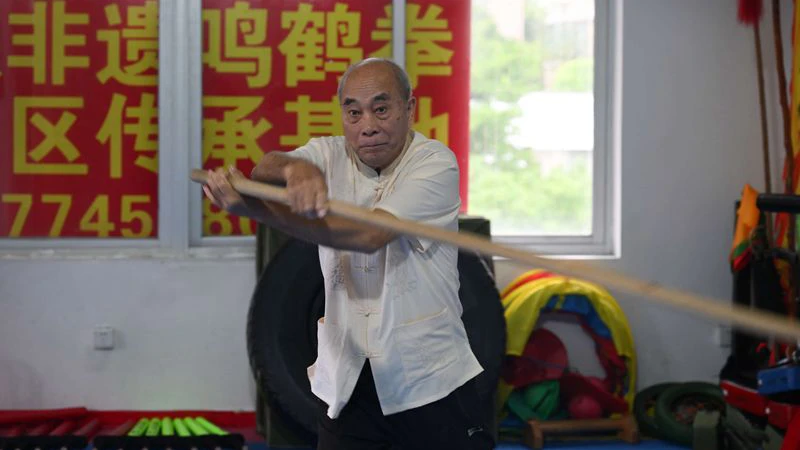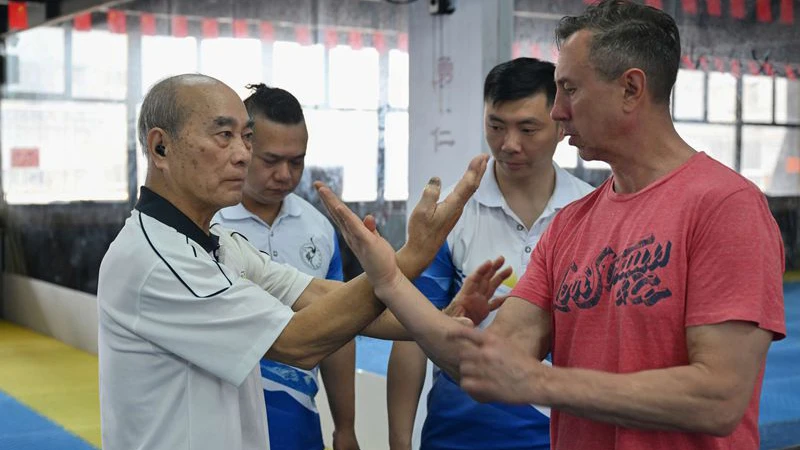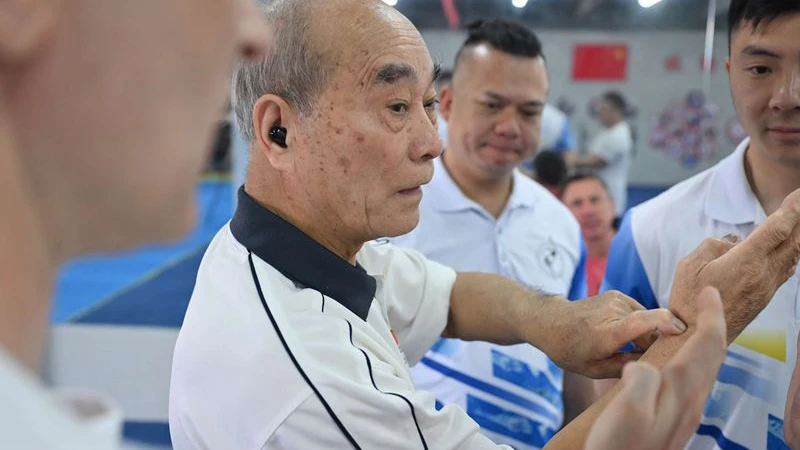In the heart of Fujian, a martial art once steeped in local tradition has made an extraordinary journey across the world. Crying Crane Fist (鸣鹤拳), a sub-style of Southern Shaolin (南少林), is now making waves in places as far away as Russia, the UK, and Australia. At the center of this cultural exchange is 77-year-old master, Yu Danqiu (余丹秋), a living legend of Crying Crane Fist who has spent the last few decades teaching both local and international students, breathing new life into this ancient practice.
Crying Crane Fist, with its distinct emphasis on crane-like movements and specialized breathing techniques, is a martial art that mimics the natural grace of the crane. Its striking movements are not only powerful but are accompanied by a unique “crane call” sound that adds to both its aesthetic appeal and practical function. Traditionally passed down within the Yu family, this martial art is now spreading beyond its original roots, thanks to the tireless efforts of Yu Danqiu and his family.

The Legacy of a Martial Arts Family
Born into a martial arts family, Yu Danqiu inherited his training from his father, who was a highly regarded master in the region. As a young boy, Yu's early life was marked by rigorous martial arts training. It wasn’t until a personal incident at the age of six that his father began teaching him Crying Crane Fist to defend himself. By the time he was a teenager, Yu had already mastered several forms of the art, including not only unarmed combat but also various weapons training. His versatility spanned traditional Chinese martial implements such as staffs, spears, and double swords, along with the Qin-Han War Sword technique—a fierce and storied part of his family’s lineage.
In 1983, after years of practicing in relative obscurity, Yu began teaching formally, and the Yu family legacy became a source of great pride in their local community. As his skills grew, so did his reputation. He was eventually named the chairman of the Fujian Provincial Martial Arts Association’s Crying Crane Fist Research Committee. Yu Danqiu's deep connection to his martial heritage, coupled with his willingness to teach widely, led to a martial arts career that has touched not just his own family, but hundreds of students across multiple continents.
Teaching Across Cultures
Yu Danqiu’s international journey began in 1988, when Japanese martial artist Miyagi Masashi sought out the origins of Okinawan karate, which shares a common heritage with Southern Shaolin styles like Crying Crane Fist. Miyagi spent months training with Yu and his father, becoming the first foreign student to be taught their family’s secret techniques. This initial experience opened the door for other international martial artists to follow, beginning with a Russian boxer named Yuri, who arrived in 2016 after seeking out various martial arts across Southeast Asia and China.
Upon meeting Yu, Yuri was immediately captivated by the depth of Crying Crane Fist’s practical combat techniques. He trained under Yu's guidance and returned to Russia to integrate what he had learned into his own fighting system, creating a hybrid style that became immensely popular in his home country. Yuri’s success marked the beginning of a larger international interest in Crying Crane Fist.
Soon after, martial artists from across Europe began making the pilgrimage to Fujian to study under Yu. In 2018, British martial arts coach Joost spent seven days learning from Yu, only to return the following year with a team of 15 students for a 12-day immersive training camp. Similar interest came from Sweden and other countries, where enthusiasts sought not just the combat applications of Crying Crane Fist but also its philosophical and cultural dimensions.
Bridging Cultures Through Martial Arts
As his students grew in number, Yu Danqiu embraced the responsibility of representing Chinese martial arts to the world. In 2017, he was invited to Australia by martial arts coaches Paul and Damien to hold workshops and teach Crying Crane Fist techniques. During his time there, his classes attracted martial arts instructors from a variety of disciplines, particularly those trained in karate. They were fascinated by the similarities and differences between their own styles and Crying Crane Fist. The blending of cultures in these workshops created a rich environment for cross-cultural exchange, allowing participants to gain a deeper appreciation for the roots of their own martial practices.
Yu’s influence continued to expand with each new visit. His second trip to Australia in 2019 solidified his reputation as a leading figure in traditional Chinese martial arts. Over the years, he has worked with martial artists from a variety of countries, including Russia, Japan, the UK, and Australia, building lasting connections with schools and practitioners worldwide. In doing so, he has not only spread the technical aspects of Crying Crane Fist but also its cultural significance, reinforcing the importance of traditional martial arts in a modern, globalized world.


